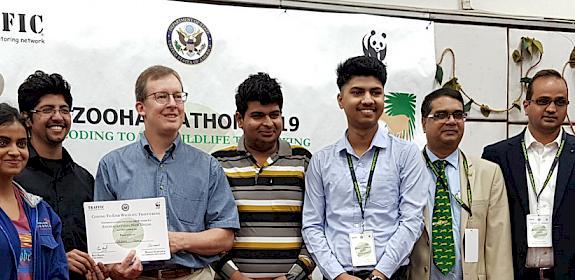CITES unveils listing proposals ahead of CoP18 in Sri Lanka
Gland, Switzerland, 4th January 2019—the Secretariat of the Convention on International Trade in Endangered Species of Wild Fauna and Flora (CITES) today revealed the proposed changes in CITES trade rules that, along with a range of other policy and implementation issues, will be discussed at the forthcoming Conference of the Parties taking place next May in Sri Lanka (CoP18).
CITES CoP meetings occur roughly every three years and changes to trade rules, through amendments to the Convention’s Appendices, can have profound conservation implications for affected species. The listing of a species in Appendix I effectively prevents all commercial international trade, while those listed in Appendix II can be traded under special permit conditions.
As is often the case, proposals relating to large, iconic mammals are likely to attract the most media interest and potential controversy. They include a proposal by several African countries to transfer the four African Elephant populations in Botswana, Namibia, South Africa and Zimbabwe from Appendix II to Appendix I, a move presumably intended to make the possibility of any future “one-off” ivory sales by these nations extremely difficult. Counter to this, Zambia is proposing its elephant population is moved from Appendix I to Appendix II—presumably to pave the way for Zambia to take part in any future sales of government-owned ivory stockpiles.
Perhaps most unusual of all is a proposal from Israel to list the Woolly Mammoth—a species that went extinct in the early Holocene—in Appendix II. The move is doubtless in response to the growing trade in mammoth ivory, which has grown in popularity as a legal alternative to elephant ivory in carvings, although their similarity causes enforcement challenges. Woolly Mammoth carcasses revealed by melting of the permafrost caused by global warming are the main source of “fresh” supplies of the tusks.
Meanwhile Namibia is asking for its White Rhino population to be changed from Appendix I to Appendix II, although specifying this would be to allow trade only in live animals and hunting trophies while Mongolia and the USA have put forward a proposal to uplist the Saiga Antelope, a Critically Endangered antelope of the Asian steppes whose population is in decline. The Antelope’s horn is used in traditional Chinese medicine but the species has in recent years been prone to mass die-offs caused by bacterial infection.
Recent CITES CoPs have witnessed a number of marine species being afforded protection under a CITES appendix listing, and this time around several marine proposals are again on the table.
They include a proposal to list two species of mako shark in Appendix II (the move follows the listing of four spark and nine species of Mobula rays species at CoP17), and proposals from several countries relating to the Giant Guitarfish, Bottlenose and other wedgefishes, and sea cucumbers. Sea cucumbers are echinoderms with a leathery skin and an elongated body, and are used as food and in traditional medicine in many parts of Asia.
Several proposals relate to reptiles, including four from Sri Lanka, the host nation, who also propose alongside the USA the listing of tiger spiders—native to Sri Lanka and India. If successful, the latter would join various tarantula species in being afforded CITES protection.
A number of species whose trade has recently been investigated and reported by TRAFFIC are also up for heightened protection. They include proposals from India to list the Asian Small-clawed Otter, Tokay Gecko and Indian Star Tortoise.
The majority of proposals relating to flora concern changes to the annotations relating to which parts of particular species can be traded. New species proposals include two from Malawi—to include Pterocarpus tinctorius and Widdringtonia whytei in Appendix II—and one from Ecuador to list the tropical Cedrela timber species: in 2007, the EU withdrew its proposal for Cedrela listings following strong opposition from a number of countries including Latin American range states.
TRAFFIC and IUCN will undertake an analysis of each of the proposals, to investigate whether they meet the appropriate biological and other criteria.
The proposals are by no means the only items on the CoP meeting agenda. There will also be important discussions based on documents submitted in advance of the meeting, including the most recent analysis of the Elephant Trade Information System (ETIS), a database of elephant product seizures managed by TRAFFIC on behalf of Parties to CITES. This analysis is expected to be posted online in the coming days.
Countries likely to come under the spotlight over their compliance with implementing CITES regulations include Lao PDR, whose wildlife markets, particularly within its special economic zones, are known to advertise banned products for sale, and Madagascar, particularly over its ability to manage illegally felled stockpiles of rosewood logs.
The issue of wildlife stockpiles and how to manage them will be one of many implementation challenges confronting Parties at the two-week conference, though steady progress is keenly anticipated relating to other implementation issues, such as how non-detriment findings (NDFs) are made, traceability through trade chains, and further measures to regulate captive-breeding of specimens.
Progress will also be assessed on the efforts being made to reduce consumer demand for particular wildlife products, with TRAFFIC being engaged as a consultant to inform discussion by Parties on the development and implementation of long-term demand reduction strategies or programmes to combat trafficking in wildlife. Last month, TRAFFIC supported the Secretariat’s hosting of an experts’ workshop to deepen insight and support impactful practices around influencing wildlife product consumer behaviour.
This will be the final CITES CoP meeting before countries meet in Beijing in 2020 under the Convention on Biological Diversity to decide on the world’s post-2020 global biodiversity framework.
The Aichi Targets in the CBD’s Strategic Plan to 2020 do not include a target specific to trade in wildlife, despite illegal and unsustainable trade being a key driver of biodiversity loss, and sustainable, well-managed legal wildlife trade having the scope to provide benefits to all from biodiversity and ecosystem services. TRAFFIC believes that establishing a target within the post-2020 Global Biodiversity Framework, which focuses on wildlife trade, is essential to ensure the political commitment and levels of implementation to address this global issue. This is central to the implementation of CITES and would ensure connectivity to the sustainable development goals (SDGs).
“CITES has clearly shown the important role it plays in reducing the pressure of illegal and unsustainable trade in wild flora and fauna on biodiversity, and enhancing the benefits to wildlife conservation and human well-being that derive from legal wildlife trade at sustainable levels,” said Sabri Zain, TRAFFIC’s Director of Policy.
“This CoP is a golden opportunity for countries to demonstrate to the international community the vital contribution CITES can make to the targets being set in 2020.”




